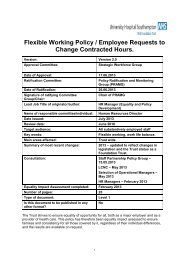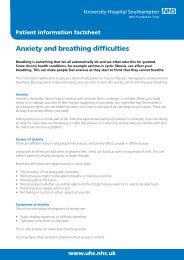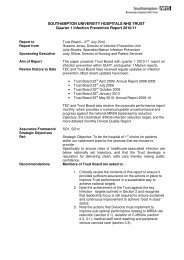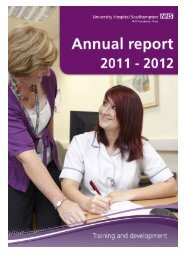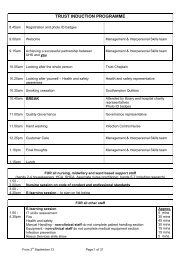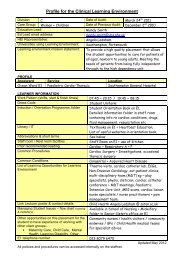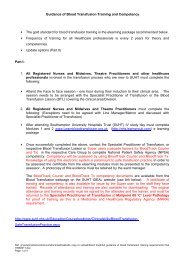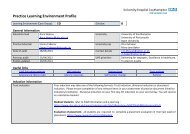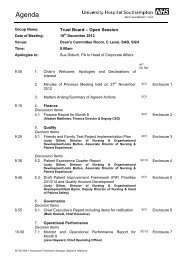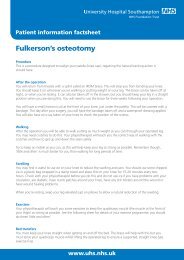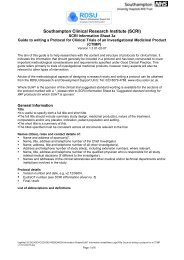ninety years of service - University Hospital Southampton NHS ...
ninety years of service - University Hospital Southampton NHS ...
ninety years of service - University Hospital Southampton NHS ...
- No tags were found...
Create successful ePaper yourself
Turn your PDF publications into a flip-book with our unique Google optimized e-Paper software.
able to respond to a radio placed on his cot and would hum the Beatles tune ‘Yellow Submarine’ Also at this time it firstbecame possible to prevent the development <strong>of</strong> severe mental handicap in cases <strong>of</strong> phenylketonuria by the strictimplementation <strong>of</strong> a very unpleasant dietary regime.It became increasingly apparent that there were a great many handicapped children in the area who required care andwhose families needed support. Their problems were complex and involved many different medical, social andeducational disciplines. It seemed essential to try to coordinate these various bodies in order to provide an integrateddiagnostic and caring <strong>service</strong>. The groundwork for this multi-disciplinary approach was laid down in the later sixties andhas <strong>of</strong> course been greatly expanded since.Also, recognition <strong>of</strong> the rubella and thalidomide types <strong>of</strong> embryopathy together with the fact that for the first time it hadbecame possible to identify human chromosomes and to relate certain syndromes such as Down’s with chromosomeabnormalities, suddenly opened up the whole field <strong>of</strong> the causation and prevention <strong>of</strong> congenital disorders. Dr ElspethWilliams went to London to learn the techniques <strong>of</strong> genetic counselling from Dr Cedric Carter and others and later carriedout a number <strong>of</strong> family studies in the <strong>Southampton</strong> district on certain hereditary disorders such as spina-bifida andcongenital heart disease. When her training was completed she set up a weekly genetic clinic at the Children’s <strong>Hospital</strong>which was one <strong>of</strong> the first in the country. In time this developed into a substantial Regional <strong>service</strong>. We were veryfortunate in having an excellent liaison with Marina Seabright who at the same time was developing a top class laboratorycytogenetic <strong>service</strong> in Salisbury.1969 saw the start <strong>of</strong> a new system <strong>of</strong> medical administration: the main clinical disciplines formed ‘Divisions’ each <strong>of</strong>which provided a representative to serve on the Medical Executive Committee which was given increased authority. TheDivision <strong>of</strong> Child Health comprised not only those consultants with child patients, representatives <strong>of</strong> the junior medical.nursing and administrative staffs but also a G.P. and a senior member <strong>of</strong> the Community Child Health Service. TheDivision proved to be a very valuable forum for the discussion <strong>of</strong> child health matters.We were also very fortunate at this time in having a close liaison with Pr<strong>of</strong>essor Donald Court <strong>of</strong> Newcastle laterPresident <strong>of</strong> the B.P.A. and author <strong>of</strong> the report ‘Fit for the Future’ . His help and advice on many matters involving thehospital was invaluable.The arrival <strong>of</strong> Mr John Atwell in 1969 had a big effect on the surgical side <strong>of</strong> the hospital. As well as developing hisregional commitments the volume and complexity <strong>of</strong> the surgical work at S.C.H. increased dramatically. His particularinterest was in the urinary tract. He was also responsible for a tremendous growth in the amount <strong>of</strong> Day Surgeryperformed; by 1973 well over a thousand such cases were treated annually including hernias and orchidopexies.An essential corollary <strong>of</strong> this was the creation <strong>of</strong> the Paediatric Home Nursing Service which he instituted with the help <strong>of</strong>Miss Isobel Ames and the M.O.H. At first this comprised two children’s trained sisters working within the boundaries <strong>of</strong> thecity but with very close ties with the hospital. This <strong>service</strong> also had the added advantage <strong>of</strong> enabling the earlier discharge<strong>of</strong> post-operative patients. From these early beginnings the <strong>service</strong> has expanded greatly under the direction <strong>of</strong> SisterPeggy Flint and Mr Atwell to become a very important national front runner.The old O.P. department was converted to provide a 5 bed ward for these cases in the previous treatment room and alsoan additional 10 bed surgical ward (Ward III). Casualty was housed in the previous consulting rooms.A new single storied temporary Out Patients building was erected in the car park behind the original block which providedconsiderable additional accommodation for consulting rooms etc.SPECIAL DEPARTMENTSPharmacyA Lady Dispenser was appointed in 1898 in order, it was hoped, to reduce thedrug bill. Miss Martin who was appointed in 1906 was paid 7/6d per week; sheresigned in 1915 for health reasons and her place was taken by MissBurniston the Hon. Secretary who was, fortunately, qualified. She complainedthat the dispensary scales, which were also used for kitchen purposes, hadbecome inaccurate and out <strong>of</strong> date. In 1924 a dispenser was loaned by Bootsfor a while to cover a gap at the hospital. In 1950 the dispensary was incharge <strong>of</strong> Miss Stevens who was followed in 1954 by Mr Miller and later in1959 by Miss TracesI am indebted to the latter for her account <strong>of</strong> “Life in the Pharmacy”“I realised after a very short time that my first impression <strong>of</strong> the Pharmacy wasfar from correct. I was escorted down a very long corridor past the warm smells <strong>of</strong> cooking, then anaesthetics, and into asmall room. The walls were clad from ceiling to floor with shelves, workbenches and banks <strong>of</strong> drawers. It was my firstventure into real pharmacy. Until then my life had been full <strong>of</strong> variety. As a freelance locum I had managed shops



